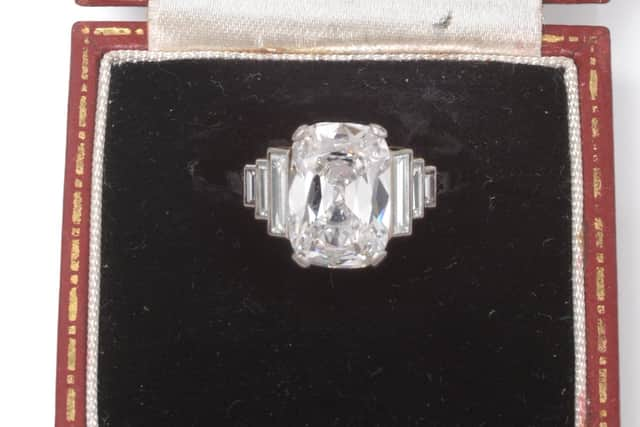The Under the Hammer column with Tennants Auctioneers


Clocks from the North East were particularly evident, with fine pieces from the Eric Morton Clock Collection grabbing much of the attention.
In total the section made a combined hammer price of £89,650 for 42 lots, with an 86% sold rate.
Advertisement
Hide AdAdvertisement
Hide AdThe top lot was a mid-18th century quarter striking table clock, made by Henry Hindley of York, which sold for £11,000 (plus buyer’s premium).


Hindley, who was born near Wigan, was a very fine and talented clockmaker who made a clock for York Minster in 1750, with an almost identical clock to the lot offered currently on exhibition at Fairfax House in York.
Selling strongly at £7,200 (plus bp) was a good George III Eight Day Dutch Striking Alarm Tableclock with Moonphase Display by Paul Rimbault of London, circa 1770, together with an early 18th century Rare Walnut Seaweed Marquetry Quarter Chiming Eight Day Longcase Clock, by David Hubert of London, selling for £5,200 (plus bp).
Fine clocks from the aforementioned Eric Morton Clock Collection were led by a fourteen-tune musical eight-day longcase clock, made by Hugh Lough of Penrith in 1773, which sold for £9,500 (plus bp).
Advertisement
Hide AdAdvertisement
Hide AdLough was born in Penrith in 1739 and worked as a clockmaker until his death in 1790.
Only around twenty clocks have been documented and these are usually eight day and thirty-hour brass dial examples.
This must be one of his masterpieces – a true reflection of his outstanding workmanship.
Further highlights from the collection included a good mid-18th century Chinoiserie Drop Dial Tavern Clock by Mark Hawkins of Bury St Edmunds, which sold for £7,000 (plus bp) against an estimate of £2,500-3,500; and a rare late 18th century Year Going Mahogany Calendar and Zodiac Display Clock, by Walker of Newcastle, which sold for £6,000 (plus bp).
Advertisement
Hide AdAdvertisement
Hide AdJewellery drew a high level of interest, particularly from private buyers, and a busy saleroom contributed to strong overall results.
A fine selection of diamond rings contributed to the top lots of the sale, the glittering pinnacle coming in the form of a circa 1935 diamond ring which was purchased by the vendor’s grandfather in the 1930s from the renowned S.J. Phillips. Centred by a 3.74 carat stone with E colour and VS1 clarity, the ring was sold for a staggering £56,000 (plus bp).
Also of note was a classic princess-cut diamond and platinum ring, which sold for £12,000 (plus bp) against an estimate of £7,000-10,000, an 18ct gold diamond solitaire ring, which sold for £11,500 (plus bp), and an early 20th century three-stone diamond ring, which sold for £5,000 (plus bp).
Period diamond brooches also sold well, with a circa 1900 diamond brooch with later pearl choker selling for £7,500 plus bp) and a further circa 1900 example selling for £6,000 (plus bp).
Advertisement
Hide AdAdvertisement
Hide AdOne of the most striking lots of the sale was a ‘Portrait of Lady Armatrude Waechter de Grimston’ by Hungarian born artist Philip de László (1869-1937), which sold for £18,000 (plus bp) after numerous bidders drove the price well above the £6,000-8,000 estimate.
De László is one of the finest portrait painters of his day, and this example was boosted with provenance from the sitter’s estate. Also selling well above estimate was Susan Isabel Dacre’s ‘Choir of Children’, which sold for £7,000 (plus bp), Charles Moreau’s ‘Reading Time’, which sold for £5,200 (plus bp), and Herbert Royle’s ‘Dales Farm in Winter’, which sold for £4,200 (plus bp).
A 19th century Chinese Porcelain Vase sourced through the Harrogate branch, which by repute was sold at the estate sale of Prince Henry Bourbon, the Count of Bardi, in Venice in 1905 sold for £3,800 (plus bp).
Also selling strongly above estimate was a Tibetan Painted Gilt and Copper Alloy Figure of Shadakshari Avalokiteshvara, likely dating from the 17th or 18th century, which sold for £3,400 (plus bp).
Advertisement
Hide AdAdvertisement
Hide AdA very unusual late 19th century mahogany and narwhal tusk cabinet was the top lot of the furniture section. Constructed with five impressive tusks, the cabinet sold for £16,000 (plus bp).
A 19th century six-piece suite of George III style seat furniture, with provenance from the Christie’s 1975 sale at Swinton House, Masham sold for £5,200 (plus bp), and a pair of late 19th century kingwood and gilt metal mounted vitrines sold for £4,100.
For further details on all auctions please call 01423 531661 or see website for details www.tennants.co.uk